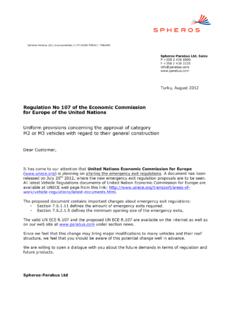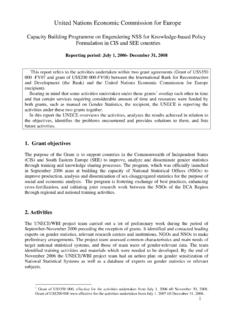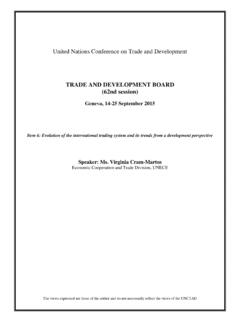Transcription of United Nations Economic Commission for Europe Work in ...
1 CSD18/2010/BP/15 United Nations DEPARTMENT OF Economic AND SOCIAL AFFAIRS Commission on Sustainable Development Eighteenth Session 3-14 May 2010 United Nations Economic Commission for Europe Work in support of Sustainable development of transport May 2010 Background Paper CSD18/2010/BP15 CSD18/2010/BP/15 2 Table of contents Table of Trends in the unece Achievements ..8 Access Transport Infrastructure Infrastructure agreements, TEM, TER and Euro-Asian Transport Links project ..8 Access Trade and transport facilitation (TTF) special attention to land-locked Affordability Analytical work and capacity building ..13 Identification of bottlenecks, missing links and quality of service in infrastructure Socio- Economic analysis of transport investment Public Private Partnerships in infrastructure development.
2 14 Safe Road traffic Vehicle Road safety Tunnel Road-Rail Level Inland Water Transport Safety conditions for transport of dangerous Environmentally friendly Role of intermodal Vehicle construction regulations and technical inspection of vehicles ..20 The Transport, Health and Environment Pan-European Programme (THE PEP) ..25 Challenges, lessons learned and way forward ..25 Growing use of the unece managed transport conventions and other legal instruments:..26 Access and infrastructure development:..26 Safety:..26 Environmental sustainability:..27 Global warming and sustainable development of Global warming and transport - UN Development Account (UNDA) project ..27 Periodic technical inspection of vehicles and other vehicle regulations ..27 ITS benefits for sustainable development ..28 The Transport, Health and Environment Pan-European Programme (THE PEP).
3 28 CSD18/2010/BP/15 3 Introduction The United Nations Economic Commission for Europe ( unece ) is one of the five regional commissions of the United Nations . It is the forum where the countries of western, central and eastern Europe , central Asia and North America 56 countries in all come together to forge the tools of their Economic cooperation. That cooperation concerns economics, statistics, environment, transport, trade, sustainable energy, timber and habitat. The Commission offers a regional framework for the elaboration and harmonization of conventions, norms and standards. The Commission 's experts provide technical assistance to the countries of south-east Europe and the Commonwealth of Independent States. This assistance takes the form of advisory services, training seminars and workshops where countries can share their experiences and best practices.
4 The objective of sustainable development is to maximise welfare, and provide a sound Economic , social and environmental base for both present and future generations. Each unece country recognizes that transportation is an important tool to help meet overall sustainability objectives. Attributes of sustainable transport follow from the expanded definition of sustainable development - sustainable transport is safe, high quality, and accessible to all; ecologically sound; economical; and a positive contributor to regional development. Specific goals for sustainable transport may include improved service quality and quality of access to goods and services, safety, improved air quality, noise reduction, improved water quality, protection of habitat and open space, historic preservation, reduced carbon emissions, increased social equity, Economic development, and a satisfying quality of life, as well as local goals consistent with the overall objective.
5 There is clear evidence that a comprehensive and high-performing transport system is an important enabler of sustained Economic prosperity: a 5 per cent reduction in travel time for all business and freight travel on the roads could generate around billion of cost savings some per cent of GDP1. In unece member countries transport sector contributes up to 10% of gross domestic product (GDP) and provides mobility, prosperity and jobs. Traditionally, new connections have played a pivotal role in periods of rapid Economic growth in many economies, but in mature economies with well-developed transport networks it is transport constraints that are most likely to impact upon a nation s productivity and competitiveness. Transport corridors are the arteries of domestic and international trade, boosting the competitiveness of imports and exports.
6 Transport networks support the productivity and success of urban areas by getting people to work, providing access to other services, supporting labour markets and allowing businesses within the area to reap the benefits of agglomeration. Mobility is critical to development. Increasing mobility is associated with Economic growth and development: - it connects people to jobs, markets and essential services. It enables businesses to contribute to development, by serving new markets and unlocking new resources. It reduces the trade barrier effect of costly and unreliable transport, enabling poor regions and Nations to become more competitive. Transport and mobility are now high on many agendas as countries and regions across the world seek to increase mobility and to lessen the negative impacts of transport.
7 Urban areas, in particular, face today the challenge of making transport sustainable in environmental (CO2, air pollution, noise) and competitiveness (congestion, other efficiency shortcomings) terms while at the same time addressing social concerns. Urban mobility is also a central component of long-distance transport. Most transport, both passengers and freight, starts and ends in urban areas and passes through several urban areas on its way. Urban areas need to provide efficient interconnection points for transport network and offer efficient last mile transport for both freight 1 The Eddington Transport Study, The case for action: Sir Rod Eddington s advice to Government, December 2006, Crown copyright 2006 CSD18/2010/BP/15 4 and passengers. They are thus vital to the competitiveness and sustainability of future transport system.
8 This paper outlines key unece contributions and reviews progress towards the development of more sustainable transport system and policies in the unece region. From sustainability point of view, inland transport in the unece region continues to face numerous challenges: Infrastructure: Road and rail networks are not adequate, coherent, interoperable and integrated. Inland waterways represent a market opportunity yet to be fully explored, while intermodal transport has not been exploited to its full potential. Border crossing: Crossing borders has always been a challenge, but current crossing times in many parts of the unece region by truck or train are too frequently too long. The main barriers are unnecessarily complex control procedures, inadequate infrastructure and lack of skilled personnel.
9 The difficulties at borders translate into lost time, inefficient us of capital, enhanced security risks, unnecessary inventory costs and higher social costs of transport workers and residents of border regions. Transport and trade facilitation: Transport and trade facilitation reduces the transaction costs and complexity of international trade by making the processes more transparent, efficient and cost-effective. However, it is an area of bipolar world of costs and benefits: measures introduced by one country may serve the interest of other countries; it can truly be beneficial for all only in multi-lateral frameworks. The environment: Transport is a source of air pollution, particularly in urban areas. Noise caused by road and rail transport generates nuisance and health hazards. Introduction of cleaner vehicles and fuels as well as less noisy engines has reduced air pollution and noise in some unece countries.
10 Emissions from the transport sector are significant and growing contributor to the overall greenhouse gas emissions in Europe . Emissions impact on long-term Economic growth by contributing to global climate change. Transport will therefore need to play an important role in an economy-wide response to that challenge. The results are promising, but much more remains to be done. Intelligent transport systems: Intelligent transport systems (ITS) integrate information and communication technology with transport infrastructure, vehicles and users. A growing number of unece members are intensively developing and implementing intelligent transport systems in various transport areas. At the same time, low income countries of unece may be handicapped not just by the poor infrastructure network, but they will have to face the consequences of a new digital divide unless they manage to accelerate their development in this field as well.



















